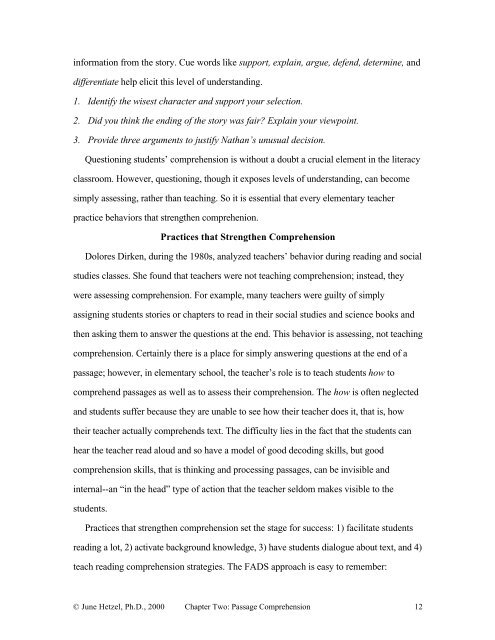Reading in the Elementary Classroom Chapter Two: Passage ...
Reading in the Elementary Classroom Chapter Two: Passage ...
Reading in the Elementary Classroom Chapter Two: Passage ...
Create successful ePaper yourself
Turn your PDF publications into a flip-book with our unique Google optimized e-Paper software.
<strong>in</strong>formation from <strong>the</strong> story. Cue words like support, expla<strong>in</strong>, argue, defend, determ<strong>in</strong>e, and<br />
differentiate help elicit this level of understand<strong>in</strong>g.<br />
1. Identify <strong>the</strong> wisest character and support your selection.<br />
2. Did you th<strong>in</strong>k <strong>the</strong> end<strong>in</strong>g of <strong>the</strong> story was fair? Expla<strong>in</strong> your viewpo<strong>in</strong>t.<br />
3. Provide three arguments to justify Nathan’s unusual decision.<br />
Question<strong>in</strong>g students’ comprehension is without a doubt a crucial element <strong>in</strong> <strong>the</strong> literacy<br />
classroom. However, question<strong>in</strong>g, though it exposes levels of understand<strong>in</strong>g, can become<br />
simply assess<strong>in</strong>g, ra<strong>the</strong>r than teach<strong>in</strong>g. So it is essential that every elementary teacher<br />
practice behaviors that streng<strong>the</strong>n comprehenion.<br />
Practices that Streng<strong>the</strong>n Comprehension<br />
Dolores Dirken, dur<strong>in</strong>g <strong>the</strong> 1980s, analyzed teachers’ behavior dur<strong>in</strong>g read<strong>in</strong>g and social<br />
studies classes. She found that teachers were not teach<strong>in</strong>g comprehension; <strong>in</strong>stead, <strong>the</strong>y<br />
were assess<strong>in</strong>g comprehension. For example, many teachers were guilty of simply<br />
assign<strong>in</strong>g students stories or chapters to read <strong>in</strong> <strong>the</strong>ir social studies and science books and<br />
<strong>the</strong>n ask<strong>in</strong>g <strong>the</strong>m to answer <strong>the</strong> questions at <strong>the</strong> end. This behavior is assess<strong>in</strong>g, not teach<strong>in</strong>g<br />
comprehension. Certa<strong>in</strong>ly <strong>the</strong>re is a place for simply answer<strong>in</strong>g questions at <strong>the</strong> end of a<br />
passage; however, <strong>in</strong> elementary school, <strong>the</strong> teacher’s role is to teach students how to<br />
comprehend passages as well as to assess <strong>the</strong>ir comprehension. The how is often neglected<br />
and students suffer because <strong>the</strong>y are unable to see how <strong>the</strong>ir teacher does it, that is, how<br />
<strong>the</strong>ir teacher actually comprehends text. The difficulty lies <strong>in</strong> <strong>the</strong> fact that <strong>the</strong> students can<br />
hear <strong>the</strong> teacher read aloud and so have a model of good decod<strong>in</strong>g skills, but good<br />
comprehension skills, that is th<strong>in</strong>k<strong>in</strong>g and process<strong>in</strong>g passages, can be <strong>in</strong>visible and<br />
<strong>in</strong>ternal--an “<strong>in</strong> <strong>the</strong> head” type of action that <strong>the</strong> teacher seldom makes visible to <strong>the</strong><br />
students.<br />
Practices that streng<strong>the</strong>n comprehension set <strong>the</strong> stage for success: 1) facilitate students<br />
read<strong>in</strong>g a lot, 2) activate background knowledge, 3) have students dialogue about text, and 4)<br />
teach read<strong>in</strong>g comprehension strategies. The FADS approach is easy to remember:<br />
© June Hetzel, Ph.D., 2000 <strong>Chapter</strong> <strong>Two</strong>: <strong>Passage</strong> Comprehension 12


